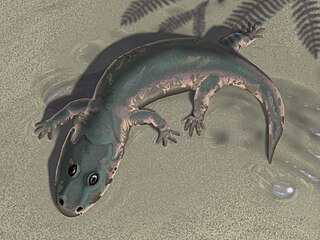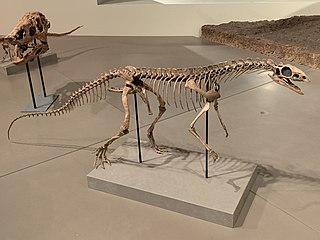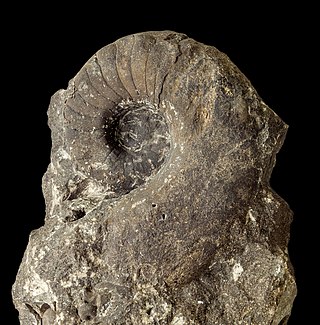
Lagosuchus is an extinct genus of avemetatarsalian archosaur from the Late Triassic of Argentina. The type species of Lagosuchus, Lagosuchus talampayensis, is based on a small partial skeleton recovered from the early Carnian-age Chañares Formation. The holotype skeleton of L. talampayensis is fairly fragmentary, but it does possess some traits suggesting that Lagosuchus was a probable dinosauriform, closely related to dinosaurs.

Camposaurus is a coelophysid dinosaur genus from the Norian stage of the Late Triassic period of North America. The pertinent fossil remains date back to the early to middle Norian stage, and is widely regarded as the oldest known neotheropod.

Hyperodapedon is a genus of rhynchosaurs from the Late Triassic period. Fossils of the genus have been found in Africa, Asia, Europe and North and South America. Its first discovery and naming was found by Thomas Henry Huxley in 1859. Hyperodapedon was a herbivore that used its beaked premaxilla and hindlimbs to dig for plants in dry land.

Acaenasuchus is an extinct genus of pseudosuchian, endemic to what would be presently be known as Arizona during the Late Triassic, specifically during the Carnian and Norian stages of the Triassic. Acaenasuchus had a stratigraphic range of approximately 11.5 million years. Acaenasuchus is further categorized as one of the type fauna that belong to the Adamanian LVF, based on the fauna of the Blue Mesa Member of the Chinle Petrified Forest Formation of Arizona, where Acaenasuchus was initially discovered.

Cryobatrachus is an extinct genus of temnospondyl amphibian from the Early Triassic of Antarctica. The type species is Cryobatrachus kitchingi. It is known from a partial skull and an imprint of the skull roof, both found in the Fremouw Formation of the Transantarctic Mountains at about 85° south latitude and described in 1974. Many small bone fragments have also been identified, although they cannot be attributed with certainty to C. kitchingi. Cryobatrachus has been classified in the family Lydekkerinidae, as it is similar in appearance to the genus Lydekkerina from South Africa. Because only a small number of features distinguish it from other lydekkerinids, Cryobatrachus kitchingi has more recently been considered a nomen dubium, meaning that its distinction from other better-known species may be unwarranted.
Arganasuchus is an extinct genus of "rauisuchian" (loricatan) archosaur. It is known from a single species, Arganasuchus dutuiti. Fossils of this genus have been found in Upper Triassic rocks of the Argana Basin, Morocco. Though its remains were initially referred to Ticinosuchus when discovered during the 1970s, in 2007 it was identified as a distinct genus with unique features of the pubis and maxilla. Arganasuchus also had several anatomical details in common with Batrachotomus, Fasolasuchus, and Postosuchus, though its relations with other loricatans remains unresolved. Arganasuchus is considered a carnivore due to its large, knife-shaped teeth.

Ptycholepis is an extinct genus of prehistoric ray-finned fish having the head and opercular bones ornamented with ridges of ganoin, minute teeth, and thick scales.

The Trigonoceratoidea are a superfamily within the Nautilida that ranged from the Devonian to the Triassic, thought to have contained the source for the Nautilaceae in which Nautilus is found.
Syringonautilidae is a family of Nautiloidea from the middle to late Triassic. Syringonautilidae comprise the last of the Trigonoceratoidea and are the source for the Nautilaceae which continued the Nautiloidea through the Mesozoic and into the Cenozoic right down to the recent. Syringonautilidae is a strictly Triassic family, derived early in the Triassic from the Grypoceratidae.

Asilisaurus ; from Swahili, asili, and Greek, σαυρος is an extinct genus of silesaurid archosaur. The type species is Asilisaurus kongwe.Asilisaurus fossils were uncovered in the Manda Beds of Tanzania and date back to the early Carnian, making it one of the oldest known members of the Avemetatarsalia. It was the first non-dinosaurian dinosauriform recovered from Africa. The discovery of Asilisaurus has provided evidence for a rapid diversification of avemetatarsalians during the Middle Triassic, with the diversification of archosaurs during this time previously only documented in pseudosuchians.
Thuringionautilus is a genus of large, moderately involute, nautiloids from the nautilid family Tainoceratidae. The whorl section is subquadrate, flanks slightly convex, venter broad with a median furrow. Ventral shoulders, narrowly rounded to subangular; umbilical shoulders, broadly rounded. Longitudinal nodes slope diagonally backwards on the venter toward the furrow. Suture, slightly sinuous. Siphuncle, subdorsal.

Metacoceras is a nautilitoid cephalopod from the Upper Carboniferous (Pennsylvanian) and Permian, the shell of which is moderately evolute with a subquadrate whorl section, bearing nodes on the ventral or umbilical shoulders or both, but otherwise smooth. The siphuncle is small, subcentral and orthochoanitic. The suture has shallow ventral and lateral lobes but no dorsal or annular lobe.

Suchia is a clade of archosaurs containing the majority of pseudosuchians. It was defined as the least inclusive clade containing Aetosaurus ferratus, Rauisuchus tiradentes, Prestosuchus chiniquensis, and Crocodylus niloticus by Nesbitt (2011). Generally the only pseudosuchian group which is omitted from Suchia is the family Ornithosuchidae, although at least one analysis classifies ornithosuchids as close relatives of erpetosuchids and aetosaurs. Phytosaurs are also excluded from Suchia, although it is not certain whether they qualify as pseudosuchians in the first place.
Rhadinosuchus is an extinct genus of proterochampsian archosauriform reptile from the Late Triassic. It is known only from the type species Rhadinosuchus gracilis, reposited in Munich, Germany. The fossil includes an incomplete skull and fragments of post-cranial material. Hosffstetter (1955), Kuhn (1966), Reig (1970) and Bonaparte (1971) hypothesized it to be synonymous with Cerritosaurus, but other characteristics suggest it is closer to Chanaresuchus and Gualosuchus, while it is certainly different from Proterochampsa and Barberenachampsa. The small size indicates it is a young animal, making it hard to classify.
Pascualgnathus is an extinct genus of traversodontid cynodonts from the Middle Triassic of Argentina. Fossils have been found from the Río Seco de la Quebrada Formation of the Puesto Viejo Group. The type species P. polanskii was named in 1966.
Jaxtasuchus is an extinct genus of armored doswelliid archosauriform reptile known from the Middle Triassic of the Erfurt Formation in Germany. The type species, Jaxtasuchus salomoni, was named in 2013 on the basis of several incomplete skeletons and other isolated remains. Like other doswelliids, members of the genus were heavily armored, with four longitudinal rows of bony plates called osteoderms covering the body. Jaxtasuchus is the first doswelliid known from Europe and is most closely related to Doswellia from the Late Triassic of the eastern United States. However, it was not as specialized as Doswellia, retaining several generalized archosauriform characteristics and having less armor. Jaxtasuchus fossils have been found in aquatic mudstones alongside fossils of temnospondyl amphibians, crustaceans, and mollusks, suggesting that Jaxtasuchus was semiaquatic like modern crocodilians.
Nundasuchus is an extinct genus of crurotarsan, possibly a suchian archosaur related to Paracrocodylomorpha. Remains of this genus are known from the Middle Triassic Manda beds of southwestern Tanzania. It contains a single species, Nundasuchus songeaensis, known from a single partially complete skeleton, including vertebrae, limb elements, osteoderms, and skull fragments.

Rugarhynchos is an extinct genus of doswelliid archosauriform from the Late Triassic of New Mexico. The only known species is Rugarhynchos sixmilensis. It was originally described as a species of Doswellia in 2012, before receiving its own genus in 2020. Rugarhynchos was a close relative of Doswellia and shared several features with it, such as the absence of an infratemporal fenestra and heavily textured skull bones. However, it could also be distinguished by many unique characteristics, such as a thick diagonal ridge on the side of the snout, blunt spikes on its osteoderms, and a complex suture between the quadratojugal, squamosal, and jugal. Non-metric multidimensional scaling and tooth morphology suggest that Rugarhynchos had a general skull anatomy convergent with some crocodyliforms, spinosaurids, and phytosaurs. However, its snout was somewhat less elongated than those other reptiles.

Etjoia is an extinct genus of traversodontid cynodonts that lived during the Middle Triassic or Late Triassic period in southern Africa. This medium-sized omnivorous cynognathian provides important information on the dental evolution of early diverging gomphodonts and traversodontids.
Dromatheriidae is an extinct family of prozostrodontian cynodonts, closely related to mammals. Members of the family are known from the Late Triassic of India, Europe and North America. Apart from a few jaw fragments, dromatheriids are mainly known from their sectorial (flesh-slicing) postcanine teeth. The teeth were fairly typical among early prozostrodontians, as they were labiolingually compressed, with a single root and crown hosting a longitudinal row of sharp cusps. Dromatheriids in particular have a very narrow and symmetrical crown without a prominent cingulum.











